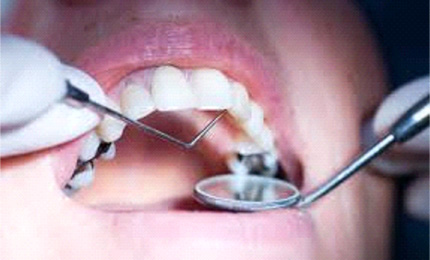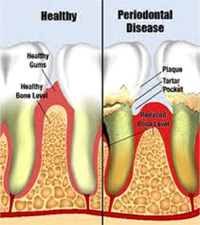
Periodontal Surgery
Periodontics – Gums Treatment
 Gum treatment is the treatment of active gum and jaw bone disease. Gum disease treatment can slow or stop the progression of gum disease. Since there are different stages of gum disease (from gingivitis to advanced periodontitis), there are different levels of treatment. In some cases, the patient may be referred to a specialist.
Gum treatment is the treatment of active gum and jaw bone disease. Gum disease treatment can slow or stop the progression of gum disease. Since there are different stages of gum disease (from gingivitis to advanced periodontitis), there are different levels of treatment. In some cases, the patient may be referred to a specialist.
In the early stages, most treatment involves scaling and root  planing-removing plaque and calculus around the tooth and smoothing the root surfaces. Antibiotics or antimicrobials may be used to supplement the effects of scaling and root planing. In most cases of early gum disease, called gingivitis, scaling and root planing and proper daily cleaning achieve a satisfactory result. More advanced cases may require surgical treatment, which involves cutting the gums, and removing the hardened plaque build-up and recontouring the damaged bone.
planing-removing plaque and calculus around the tooth and smoothing the root surfaces. Antibiotics or antimicrobials may be used to supplement the effects of scaling and root planing. In most cases of early gum disease, called gingivitis, scaling and root planing and proper daily cleaning achieve a satisfactory result. More advanced cases may require surgical treatment, which involves cutting the gums, and removing the hardened plaque build-up and recontouring the damaged bone.
The procedure is also designed to smooth root surfaces and reposition the gum tissue so it will be easier to keep clean.
Gum disease often results in the recession of the gums, causing the teeth to look longer. In the past, the cutting away of the gums, called gingivectomy, also made the teeth look longer. Newer techniques have been developed that require less removal of tissue and superior results.
Removing plaque through daily brushing, flossing and professional cleaning is the best way to minimize your risk.
Patients should visit the dentist every 3-4 months (or more, depending on the patient) for spot scaling and root planing and an overall exam. In between visits, they should brush at least twice a day, floss daily, and brush their tongue. Manual soft nylon bristle brushes are the most dependable and least expensive.
Gum Surgery, Curettage
Treatment of early gum disease involves oral hygiene and removal of bacterial plaque. Moderate to advanced gum disease usually requires a thorough cleaning of the teeth and teeth roots called “root planing” and “subgingival curettage.” Root planing is the removal of plaque and tartar (hardened plaque) from exposed teeth roots while subgingival curettage refers to the removal of the surface of the inflamed layer of gum tissue. Both of these procedures are usually performed under local anesthesia and may be accompanied by the use of oral antibiotics to overcome gum infection or abscess. Follow-up treatment may include various types of gum surgeries. In advanced gum disease with significant bone destruction and loosening of teeth, teeth splinting or teeth extractions may be necessary.
Bone grafts
A basic part of any spinal fusion is the bone graft. Bone grafting is used for many types of orthopedic procedures that require bones to heal. Bone grafting is used in two main ways during orthopedic procedures:-
- To stimulate the bone to heal
- To provide support to the skeleton by filling gaps between two bones
The most common use of bone graft is to stimulate the healing of bone.The bone graft is used like “fertilizer” to stimulate and speed the bone healing process. Bone tissue that is crushed into powder and placed around a fracture or a fusion site has chemicals in it that stimulate the nearby bones to heal. If the bone is taken from the person’s own body, there may also be osteocytes (living bone cells) that survive being transferred to the new location and continue to do their work of making new bone. Even bone taken from someone else will stimulate bone to heal. But bone taken from the same person may be better because the chances are higher that it will have remaining live bone cells after the transfer.
the bone healing process. Bone tissue that is crushed into powder and placed around a fracture or a fusion site has chemicals in it that stimulate the nearby bones to heal. If the bone is taken from the person’s own body, there may also be osteocytes (living bone cells) that survive being transferred to the new location and continue to do their work of making new bone. Even bone taken from someone else will stimulate bone to heal. But bone taken from the same person may be better because the chances are higher that it will have remaining live bone cells after the transfer.
